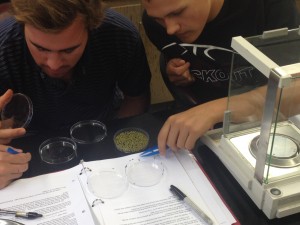Evolution by natural selection is the uniting principle behind all of biology. This semester, Hampden-Sydney introductory biology students are studying evolution using the bean beetle (Callosobruchus maculatus), an agricultural pest that lives off of beans and which normally resides in the subtropics of Africa and Asia.
The students are doing an experiment in which they simulate a “bottleneck effect”…….if large beetles are separated from small beetles and only allowed to mate with beetles of the same size, will all the offspring be the same size as their parents? The experiment required the students to get a crash course in weighing and moving beetles and generating new beetle crosses.
The beetles will lay eggs on supplied mung beans, and the larvae and pupae will develop inside them. When the adults emerge after 3-4 weeks, the students will find out how well the size of the beetle can be influenced by artificially selecting the parents. The use of bean beetles is a new approach towards allowing Hampden-Sydney students to take a hands-on approach to the study of evolution.



